
Imagine it is the late 1200s and you are a smallholder who owns a farmstead which nestles in the lee of the mighty stronghold of Okehampton Castle. Life his hard and not made any easier by the rule of Lord Hugh Courtenay who lives in the nearby castle. Despite all the hardships you are managing to grow some crops and rear a few cattle, sheep and pigs all of which put food on your table and a few coins in your purse. Home is a simple longhouse, nothing to boast about but it’s warm and dry(ish) and keeps out the majority of the Dartmoor weather. When times are good your wife and five children are perfectly happy with their lot. Then suddenly one day the castle steward knocks on your door and tells you in no uncertain terms that Lord Hugh has decided to extend and re-develop his deer park in order that he and his friends might enjoy the odd days hunting. Oh and by the way, your farmstead is sitting slap back in the middle of this proposed deer park which means you and your family are going to have to move out. No ifs or buts, the farmstead is to be demolished, your fields are to be planted with trees and where you go is up to you. You cast your eyes up to the castle above and curse the lord, his friends and the deer, all the hard work you have put into the small farm was for nothing, deer are more important in Hugh Courtenay’s view. The picture below shows the castle of Hugh Courtenay from the wooded deer park and the aspect his guests would have got from the various lodgings.
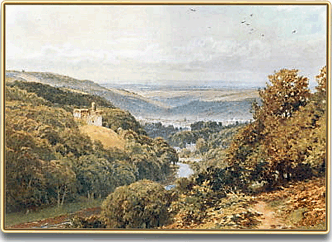
Harry Sutton Palmer – c.1910
Although it was not a helpful event for those removed this act imparkement has left us with numerous features in the modern landscape. The homes of those evicted are traceable at the site of the Deserted Medieval Village as is evidence of the actual deer park in the form of ditches and walls, all of which make for exploration.
The Deer Park
There are two deer parks to be found on Dartmoor, Okehampton’s medieval one and a later Elizabethan example at nearby Whiddon Park, remains of both are still visible in today’s landscape. However, there is a place-name near the Metheral Brook called ‘Deer Park Corner’ (SX 67720 84086) which is odd as the angle of the enclosure wall to which the name refers belonged to a farm called Willandhead. However, the corner is very near the Metherall Brook which in 1240 perambulation of The Forest of Dartmoor was known as The Aber, hence Alberysheved. In which case the Forest being a royal hunting ground may well refer to that as being the deer park?
According to the English Heritage Thesaurus a deer park is: ‘a large park for keeping deer. In medieval times the prime purpose was for hunting‘. Deer parks are mention in several Saxon documents where they are referred to as, ‘Derhaye‘ or ‘deer-hay‘, another name which appears in Saxon charters is haga and is considered to be the etymological root of the word hay. This fact is bourne out by Clark Hall, (2004, p.166) who defines the word as meaning a hedge or enclosure. Hooke, (2001, p.157) suggests that a haga was a type of pale which consisted of an earthen bank along which a timber palisade or hedge was laid. The whole idea of these pales or fences was to control deer and in later years the term haga came to mean a deer park. There does seem to be a slight confusion as to the various terms, Shirley (1867, p.10) suggests that a deer park was a tract of land intended for keeping deer for purposes of hunting. Deer Hays were areas where by means of traps, wild deer were caught and then transferred into the deer parks. Either way there is evidence to indicate that during Saxon times deer hunting was taking place in the form of a Colloquy written by a monk called Ælfric in the 10th century. Here he writes: ‘I weave myself nets and set them in a suitable place, and urge on my dogs so that they chase the wild animals until they come into the nets unawares and are thus ensnared; and I kill them in the nets… I kill stags in the nets.‘, (Hooke p.159). It is therefore quite possible that deer hunting was an occurrence at Okehampton prior to the Norman period, many writers go further and contend that nationwide deer parks were in existence prior to the arrival of the Normans.
The Domesday Book lists 37 parks where they are either recorded as parcus (park) or haia (hay) but Liddiard (2003, p.7) considers that this figure, ‘falls short of reflecting the true number in England at the time of the Domesday Inquest‘, (1086). Of the 37 parks recorded, 9 belonged to the king, 5 were held by bishops or monastic houses and the other 23 were owned by various Norman aristocrats. At this time there was only one parcus bestiaru or ‘park for beasts’ recorded in the whole of Devon and that was at Winkleigh which is about 9 miles from Okehampton, (Morris, 1985, p.101 b, c). The whole concept of a ‘park’ was that it was isolated in the landscape by some physical land division, such as a pale, for the whole purpose of preserving the beasts of the chase. The enclosed park served two purposes; firstly it kept out wild animals that could cause harm to the deer or the vegetation and secondly it contained the deer thus preventing them causing grazing damage to nearby crops, (Beresford, 1984, p.193). In effect a deer park, although used for hunting, could be regarded as a larder where live meat was kept until such a time as it was required for the table. Rackham (2001, p.152) contends that by 1300 there were about 3,200 parks in England which accounted for 2% of the country. No self-respecting nobleman would forgo the status of owning a deer park and at Okehampton the Courtenays’ were no exception. It was this precise use that Okehampton Castle became known for, somewhere that the lord and his guests could stay and be entertained whilst enjoying the hunting.
It has been suggested that one of the reasons for the enormous growth in deer park numbers was the re-introduction of the fallow deer. Prior to the last Ice Age, fallow deer were widespread but then died out, in 1061 Roger I of Hauteville took the island of Sicily from the Arabs where he found fallow deer being kept. It is thought that the Henry I knew of the deer and imported some breeding stock from Richard II of Sicily and introduced them to the deer parks between 1100 and 1135, (Rackham, 1998, p.47). One important point to remember is that venison could in the medieval period be regarded as priceless, there were only two ways to acquire it, as a gift or to poach it, (Rackham, 1989 p.125). The former route of acquisition meant you were well in with the nobility and the latter, if caught, would attract severe punishment. Occasionally the king would make gifts of live deer to those who were in favour either to replenish a dwindling herd or to simply boost numbers.
Anyone could create a deer park as long as they owned land and had enough money to fund its creation, one of the costs would have been the license which had to be purchased from the king and no deer park could be established without one. The obvious reason for this was to put coin into the regal coffers from nobles who were desperate to show their status by way of a park. Rackham (2000, p.59) considers that a deer park ‘symbolised a higher status than a moat but lowers than one’s private gallows‘. The parks in many cases also provided other resources such as grazing for domestic animals, timber and wood, all of which would have fetched a monetary return.
It has been suggested that a medieval deer park could be viewed as a multi-layered space with four distinct layers which are defined as; imagination, economic, legal and physical as depicted below;
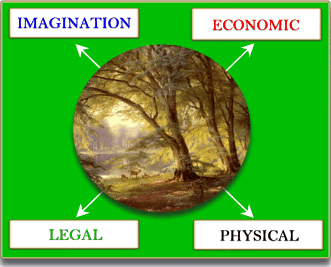
The imagination layer would encompass the religious, ideological and aesthetic properties that dwell in the mind of any person looking at the park. The economic layer would be the comparative value of the land, fauna and flora that were contained within the park. The legal aspect would be concerned with the actual ownership of the land and its associated authority and finally the physical layer includes the topography and soil of the land along with its fauna and flora. All four aspects merge together to form the living deer park of the medieval world with varying degrees of import, (Pluskowski, 2007, p.64).
There were certain periods during the year when all such activities had to stop, these were called ‘fence months’. The first period would be during the fawning time which traditionally was the two weeks each side of Midsummer’s Day and a month in the autumn which coincided with the annual rut, (Birrell, p.116).
Although some deer parks may have looked like forests in the literal sense there is one important distinction between the two; only a king may own a Forest (as in the Forest of Dartmoor) whereas anyone with the wherewithal could own a chase or park. The parks were normally managed by a parker (the origin of the surname) and his servant which contrasted with the many officers and employees of a Forest.
Quite often the noblemen of the time would own several manors (as at Okehampton) and would therefore have the use of different deer parks. This meant that the family would travel between manors with their retinue of companions and friends and then dine off the game from the various hunts, (Muir, 2005, p.129). But what did a medieval deer park look like? Muir, (2007, p.241) and Rackham (2000. p.60) describe such a picture;
‘… it was the ‘wood pasture and woodland’ scenery that park owners liked to create. In such a countryside of tree-dotted lawns, tree clumps and compact woods, there was fairly open, closely grazed pasture across which the deer could be coursed, but there was also cover, preventing the quarry from becoming too neurotic, and lots of well-spaced pollarded trees. These yielded leaf fronds that could be lopped down for browse as well as giving concealment to stalkers.’
‘Parks were of two kinds. Uncompartmented parks were accessible to deer at all times; the trees were pollarded to protect regrowth, and new trees arose in periods of slack grazing or in the protection of thorns or hollies. Other parks were compartmented. A park would be divided into coppices, each of which would be felled like an ordinary wood and then fenced to keep deer out until it had grown sufficiently not to be damaged. Some compartments might be accessible to deer all the time; these were called launds, and were grassland with pollarded trees. There was a park lodge where parkers did their business, set so as to command a view of whatever was not hidden by trees’.
The deer park would have been encompassed both a large earthen bank with either a wooden pale or hedge on the top, or in some cases a stone wall would be substituted. These became known as deer leaps or on Dartmoor as leapyeats and the whole purpose of their design was to allow deer to enter the park but to prevent them from escaping. This was achieved by creating an inward facing scarp which allowed the deer to jump into the park and meant that the rise from inside was too steep to allow them to jump out as can be seen below.
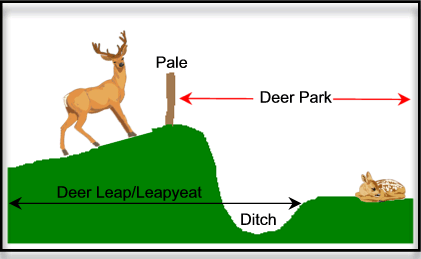
In some documents the deer-leap was referred to as a saltatorium or saltory which meant a pit fall,
Other features that could be found in a deer park were towers from which people could observe the hunt or be used as firing platform for archers.
The actual method and ethos of early hunting was all targeted in killing deer for food, in later years the emphasis changed to the thrill of the chase. Shirley (p.11) describes the early hunting method thus:
‘They had neither the means of giving chase or of killing at a distance, so they used stratagem to bring the game within reach of their missiles. A labyrinth of alleys was penned out at a convenient part of the wood, and here the archers lay under covert. The hunt began by sending men round to break and beat the wood, and drive the game with dogs and horns into the ambuscade. This pen is the haia so frequently occurring among the silvae of Domesday. Horns were used, not, as with us, to call the dogs but to scare the game. In fact, it was the battue, which is now, under altered circumstances, discountenanced by the authorities of the chase, but in early times was the only way for man to cope with the beasts of the field.’
There are several depictions in medieval illuminated manuscripts that show the various stages of a deer hunt, below are just two examples which depict the deer being chased by dogs and horns and then being killed by archers as described above.
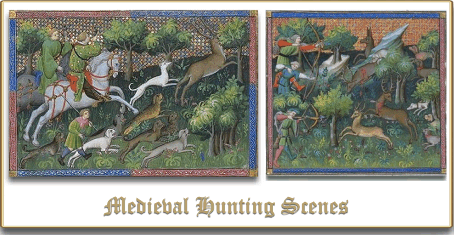
Having looked at deer parks in general it may be as well to focus on Okehampton. There can be no question that one of the purposes for the redesigning of the castle in the early 1300s was the deer park. Creighton and Freeman, (2006, p.117) notes the following: ‘Okehampton provides another instructive example of a castle embedded in a parkland landscape… To the south where the site was embraced by a deer park, the window seats in sumptuous domestic lodgings in the donjon and bailey enjoyed spectacular views unimpeded by defences‘. This was a wealthy lord going out to impress his guests by way of a status symbol in the form of a deer park. This resulted in the clearance of numerous farmsteads and the loss of common rights upon the land but not before a dispute with the folk of Okehampton
‘Emparkment could also result in the disruption and even displacement of settlement. At Okehampton the earls of Devon cleared the area south of their castle of farmsteads and removed the community’s rights to other agricultural resources in order to create a vast and conspicuous greenbelt around their seat of lordship in the thirteenth century. A remarkable document of 1292 records an agreement between Hugh de Courtenay and the burgesses of Okehampton whereby rights to common pasture in the zone later occupied by the park were exchanged for access to wastes and woodlands elsewhere on the fringes of Dartmoor, while part of the Courtenay’s own demesne was also converted from arable to parkland.’, (Creighton, 2002, p.191).
‘The settlement on Okehampton Park was abandoned around 1300… and the abandonment of the settlement probably relates to the creation of the Okehampton Deer Park about 1292 – 1306, as a hunting preserve for the earls of Devon.’, (Pearce, 1981, p.217).
The actual document that Creighton refers to was basically a compromise to allow the deer park to be established, it actually reads thus:
‘Know all to whom the present writing shall come Hugh de Courtenay, the Provost and Commonality of Okehampton send greetings to God. All know what is in controversy between the said Hugh on the one part and the Provost and Commonalty of the Borough of Okehampton on the other part concerning common of pasture in woods, wastes and in other places in the manor of Okehampton. The controversy between the said Hugh, the Provost and Commonalty was overcome in this manner, namely, the said Provost and Commonalty for themselves, their heirs and assigns of their own good and lawful will, have released and quit-claimed to the said Hugh and to his heirs all their right and claim which they have or will have in the whole of the wood of the said Hugh situated to the south of the castle and the borough of Okehampton everywhere and at all times of the year. And the said Hugh of his own good and pure will, assisting the said Provost and Commonalty, for himself and his heirs, grants the said Provost and Commonalty, their heirs and assigns, that they may have common pasture for all animals throughout his whole wastes between his arable land at Byrham towards the south and the borders of Dartmoor throughout the whole year, with free and peaceable ingress and egress from the said Borough through the middle of the said south wood, by way of Rodmore unto the said waste. And likewise they may have common of pasture for all their beasts throughout the whole demesne of the said Hugh of Okehampton, from the morrow of St. Michael until the middle of the month of March. Moreover, that each Burgess may have a sow and four little pigs in his wood called Hokwood in the northern part of the said Borough, at the time of mastage, free from pannage, throughout the whole of the said wood, except such part thereof as the said Hugh and his heirs undertake to in future enclose. And the said Hugh and his heirs undertake to warrant and defend forever the above mentioned common pasture of the lord and the pannage of pigs to the before mentioned Commonalty, their heirs and assigns, without disturbance by the said Hugh or any of his servants. For the above mentioned grant of common pasture the Provost and Commonalty have given to the said Hugh, their lord, two tuns of wine beforehand. In witness whereof this writing confirmed in the form of a chirograph, the said common seal, and the said Portreeve and Commonality, their seal, have interchangeably appended.
Witnessed by: Lord Henry de Raleghe, Robert Beaupel, knights, Nicholas de la Hoke, Elya Coffin, William de Cockyscombe, Roger de Durneford, Walter atte Byare and others. Given at Okehampton, Tuesday, in the festival of St. Thomas the Martyr in the 20th year of the reign of King Edward I.’, (Young, 1931, pp 25 – 26).
This document was drawn up on the 29th of December 1292, having come to a compromise Hugh de Courtenay even then manages to extract 2 tuns of wine from the good folk of Okehampton which to put it into some perspective equates out to 504 gallons. But as history shows the de Courtenay family had its deer park which they maintained until 1539 when Henry VIII beheaded Henry Courtenay and confiscated his lands and disparked the hunting grounds . It is estimated that the total extent of the deer park was around 1,700 acres, (Endacott, 2003, p.12), but what evidence is there of the deer park today?
The first port of call has to be the cartographical evidence which will show later boundaries of the park. There is a map dating from the 1600s which shows the park’s boundary which does allow for an estimation of the limits as show below:
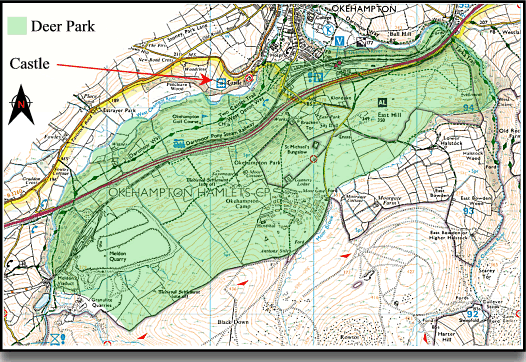
The park is also included on Benjamin Donn’s map of 1765 and also is depicted on the Ordnance Survey map of 1809 but as can be seen from the above O.S. map it’s no longer shown. Sadly as can be seen from the modern map the park has over the centuries recieved the attention of man in the form of a railway, a quarry, a golf course and military camp being build in it.
|
Donn’s 1765 map |
1809 O.S. map |
2008 Aerial View |
According to English Heritage the visible field evidence consists of parts of the pale and edges of the park that are contained by dry stone walls. This is all well and good but what do you look for on the ground? These enclosing earthworks can be pronounced with deep ditches on the inner sides of the pale bank or stone walls. On the higher ground of the old park may be walls or platforms which once belonged to the lodge or hunting towers. Old trees such as oak can be another hint of a deer park, especially those with huge girths that show signs of pollarding. Once disparking had taken place the land was usually parcelled up and enclosed, this had the effect of presenting continuous and curving hedgerows or walls that encircled small, neat enclosure, (Muir, 207, p.244).
Near to the castle is an enclosure which is known as the ‘kennel field’, this is more than likely where the hunting dogs for the castle were kept, (Endacott, 2003, p.12). On the southern edge of the park is a spot known as ‘Saxon Gate’ (still marked on the modern O.S. map) and of this Hemery, (1983, p.865) notes:
‘Two drove-ways are traceable, and the ancient way to Okehampton forms the base line of the settlement, being the track through the ancient Okehampton Park from Meldon to the town. A moorgate on this track – far older than the higher Moor Gate but now a mere subsidiary to it – has for centuries borne the name ‘Saxon Gate’, and beside it are the ruins of two later homesteads, Saxon Farm and Saxon Gate bungalow.’
Disregarding the homesteads, could this place-name be an inheritance from before the emparkment which for some reason stuck to a gate which led from the park onto the moor?
The general thinking is that ‘parks’ in later centuries were very much based on the medieval deer parks except they were no longer used for hunting and took on an ornamental persona. Some of these landscaped parks still kept herds of deer but all were seen as a status symbol, no great seat was complete without an impressively expensive park. In this light it could be argued that the modern garden ethos was also born from this ideal, afterall we all strive for immaculate gardens in which guests can be entertained and impressed.
Reference.
Beresford, M. 1984. History on the Ground. Gloucester: Alan Sutton Publishing.
Clark Hall, J. R. 2004. A Concise Anglo-Saxon Dictionary. Canada: Cambridge University Press.
Creighton, O. & Freeman, J. P. 2006. Castles in the Medieval Landscape. In: Turner, S. (ed.). Medieval Devon and Cornwall. Macclesfield: Windgather Press.
Creighton, O. 2002. Castles and Landscapes. London: Equinox Publishing.
Endacott, A. 2003. Okehampton Castle. London: English Heritage.
Hemery, E. 1983. High Dartmoor. London: Hale Publishing.
Hooke, D. 2001. The Landscape of Anglo-Saxon England. London: Leicester University Press.
Liddiard, R. 2003. The Deer Parks of Domesday Book. In Landscapes 2003 Vol. 4 No. 1, Macclesfield: Windgather Press.
Morris, J. (ed.) 1985. Domesday Book – Devon (Part One). Chichester: Phillimore & Co. Ltd.
Muir. R. 2007. Be Your Own Landscape Detective. Stroud: Sutton Publishing.
Muir, R. 2005. Ancient Trees – Living Landscapes. Stroud: Tempus Publishing.
Pearce, S. 1981. The Archaeology of South West Britain. London: William Collins and Co. Ltd.
Pluskowski, A. 2007. The Social Construction of Medieval Park Ecosystems. In The Medieval Park, Liddiard. R. (Ed.) Macclesfield: Windgather Press.
Rackham, O. 2001. Trees and Woodland in the British Landscape. London: Phoenix Press.
Rackham, O. 2000. The Illustrated History of the Countryside. London: Seven Dials, Cassell & Co.
Rackham, O. 1998. The Last Forest. London: Phoenix Press.
Rackham, O. 1989. The History of the Countryside. London: J. M. Dent and Sons, Ltd.
Shirley, E. P. 1967. Some Account of English Deer Parks. London: John Murray.
Young, E. H. 1931 Parochial Histories of Devonshire – Okehampton. Exeter: The Devonshire Association.
Bibliography.
Hoskins, W. G. 1992 The Making of the English Landscape. Sevenoaks: Hodder & Stoughton.
Jones, R. & Page, M. 2006. Medieval Villages in an English Landscape. Macclesfield: Windgather Press.
 Legendary Dartmoor The many aspects past and present of Dartmoor
Legendary Dartmoor The many aspects past and present of Dartmoor




Thank you for this article on Deer Parks in Dartmoor. I was Googling “saxon deer parks in england”. In fact I am trying to prove that the park in Winkleigh was a Saxon creation, as the Saxon owner was a Very Important Thegn. The holders after Domesday were tenants of Matilda with their own manors, so not likely to have built a park by 1086.